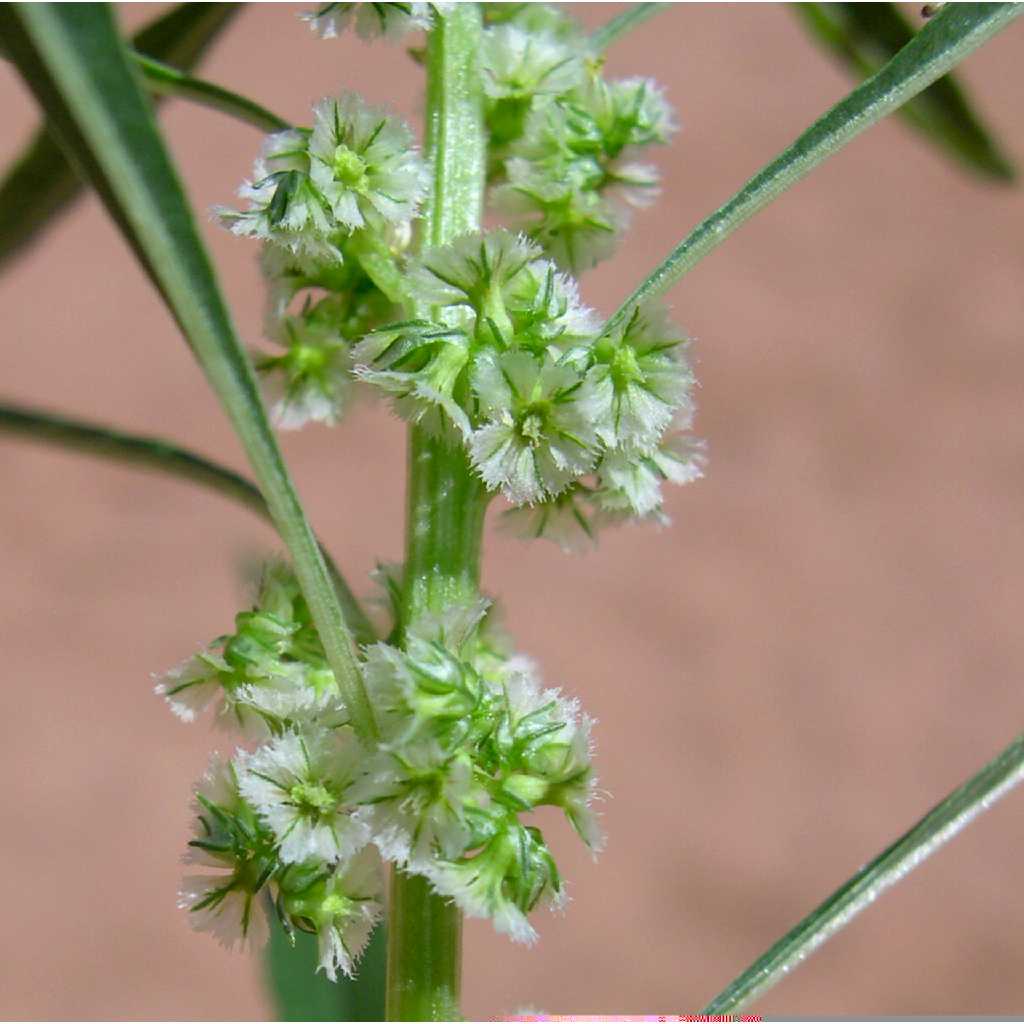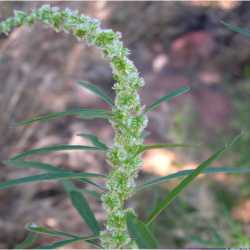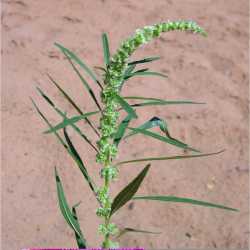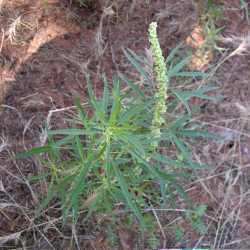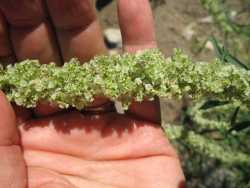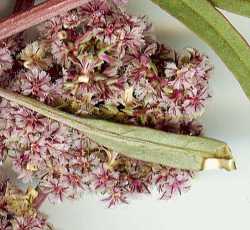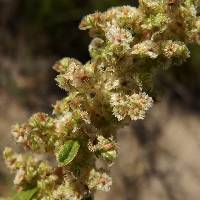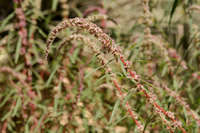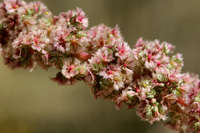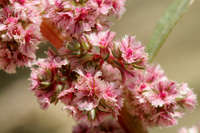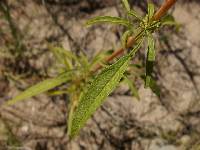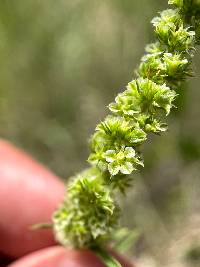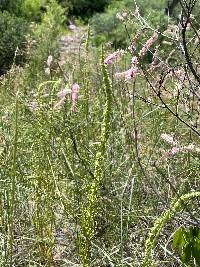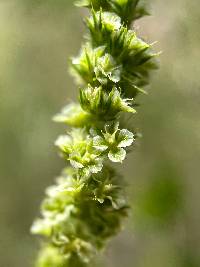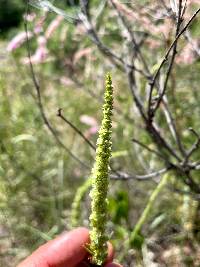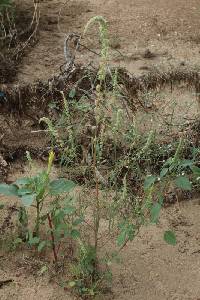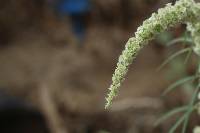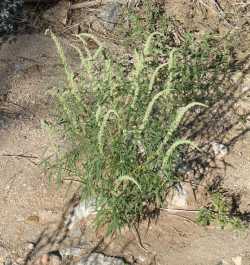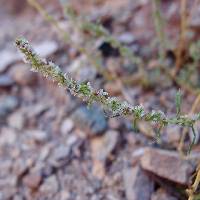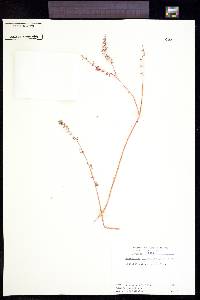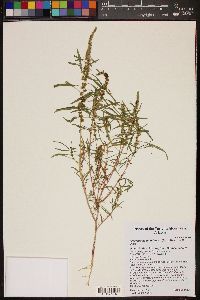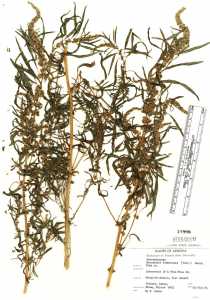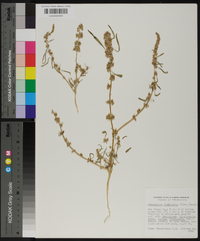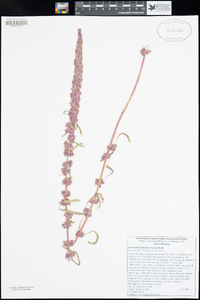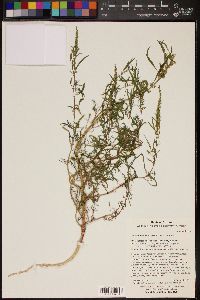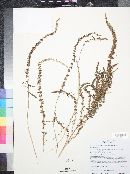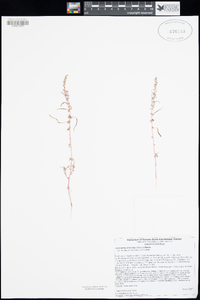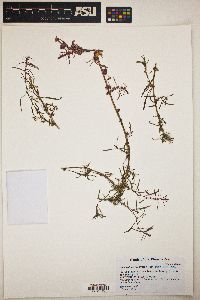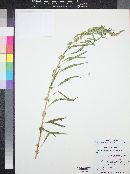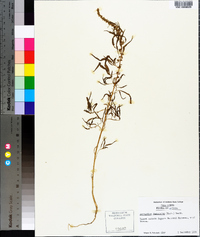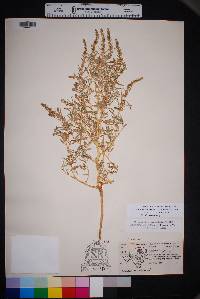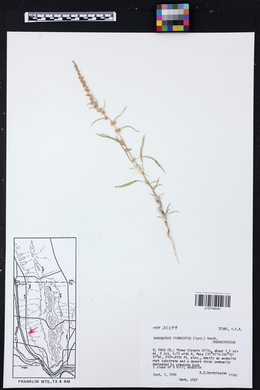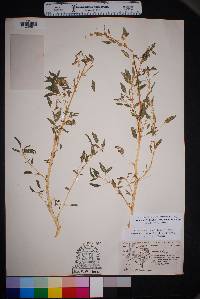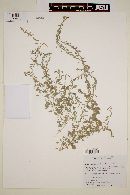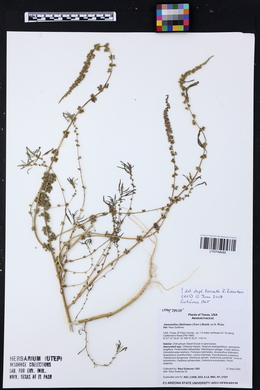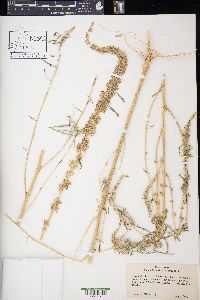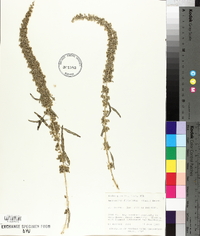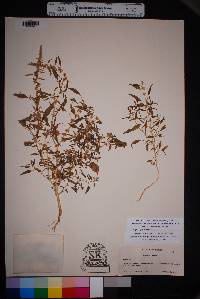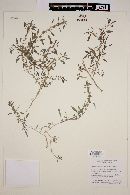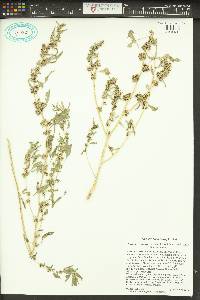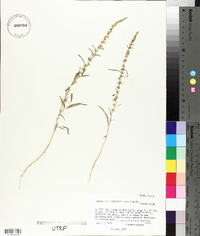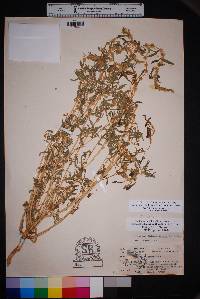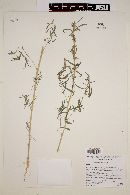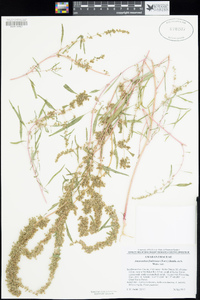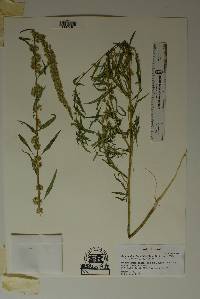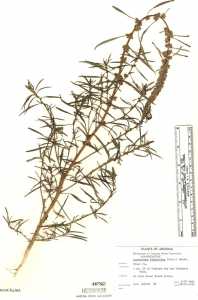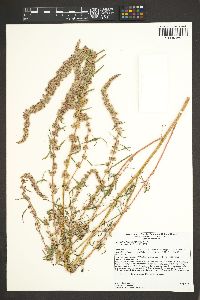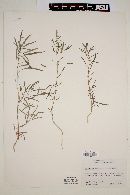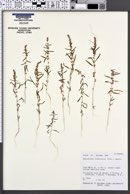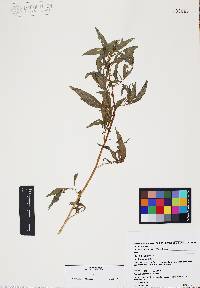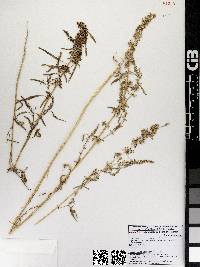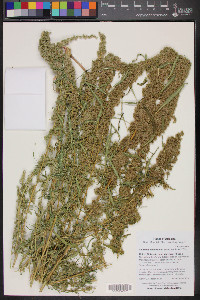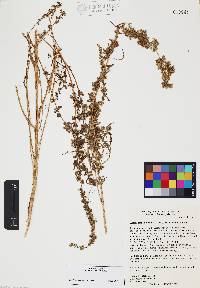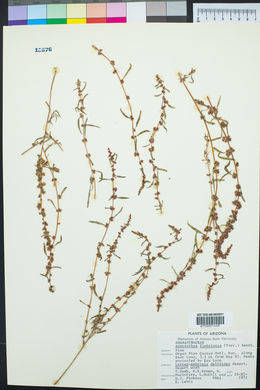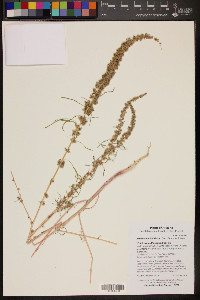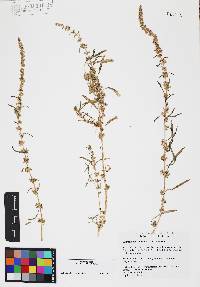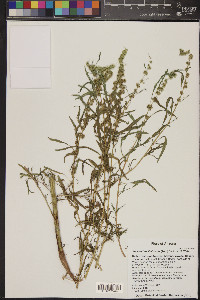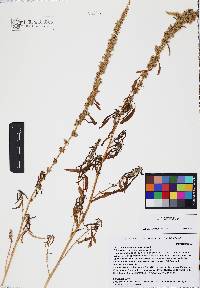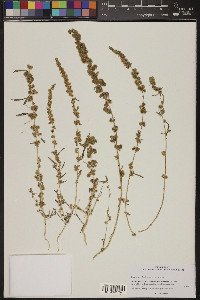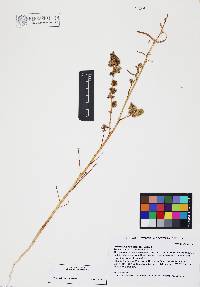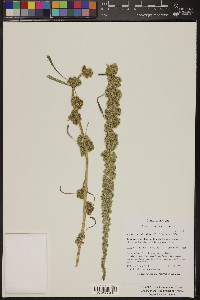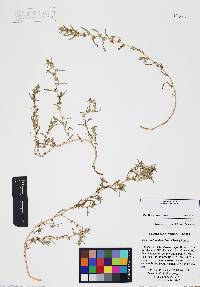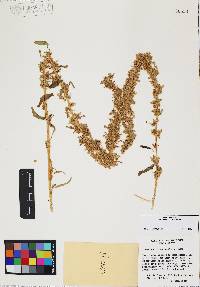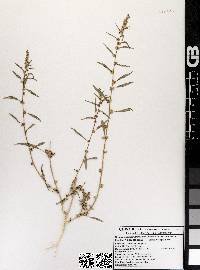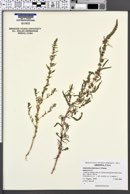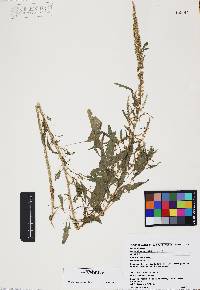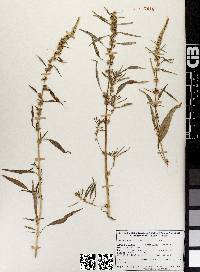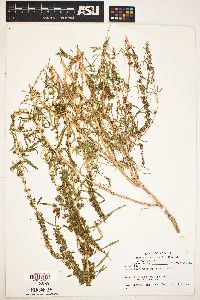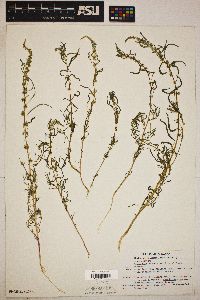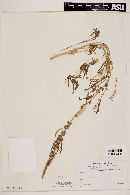Amaranthus fimbriatus
|
|
|
|
Family: Amaranthaceae
Fringed Amaranth, more...pigweed, blite, fringed pigweed (es: quelite, bledo)
|
Plants glabrous. Stems erect or with lateral branches ascending, usually branched from base, main and lateral stems sparingly branched or simple, 0.3-0.7(-1) m. Leaves short-petiolate; petiole 1/4-1/2 as long as blade; blade linear to narrowly lanceolate, (1-)2-6(-10) × 0.1-0.5(-1) cm, base narrowly cuneate, margins entire, plane, apex acute to mucronulate. Inflorescences mostly axillary clusters scattered from base to apex of plants, distally condensed in lax, unbranched, almost leafless, slender, terminal spikes, interrupted. Bracts of pistillate flowers ovate to ovate-lanceolate, 1-1.8 mm, shorter than tepals, about 1/2 or less as long as tepals. Pistillate flowers: tepals 5, reflexed, fan-shaped to broadly spatulate, clawed, equal or subequal, 1.5-3.3 mm, margins fimbriate or denticulate, apex much expanded and obtuse; style branches erect to ± spreading; stigmas 3(-4). Staminate flowers: tepals 5, apex obtuse; stamens (2-)3. Utricles subglobose to obovate, 1.2-2 mm, shorter than tepals, rugose to nearly smooth, dehiscence regularly circumscissile. Seeds black or dark reddish brown, lenticular to broadly lenticular, 0.8-1 mm diam., shiny, smooth. 2n = 34. Flowering summer-fall (in arid regions mostly after summer rains). Sandy, gravelly slopes, washes, semideserts, disturbed habitats; 500-1700 m; Ariz., Calif., N.Mex., Tex., Utah; n Mexico. Two varieties of Amaranthus fimbriatus have been recognized: var. fimbriatus, with tepals fimbriate at the apex, and var. denticulatus (= A. venulosus S. Watson), with denticulate or crenulate tepals. The latter is reported from Arizona and adjacent northern Mexico; it probably occurs more widely. A related species, Amaranthus chihuahuensis S. Watson, which occurs in Mexico (Chihuahua and Oaxaca), was reported from trans-Pecos Texas, but no reliable specimens were seen by C. F. Reed (1969b). The presence of that species in the United States needs confirmation, and its taxonomic identity remains obscure.
FNA 2003, Wiggins 1964, Kearney and Peebles 1969 Duration: Annual Nativity: Native Lifeform: Forb/Herb General: Glabrous annual herb, often with a reddish tinge; stems erect with lateral, ascending branches, usually branched from base; main and lateral stems sparingly branched or simple, 30-70 cm tall. Leaves: Alternate, short-petiolate, the petiole a quarter or half as long as blade; blade linear to narrowly lanceolate, 2-6 cm long by 0.1-0.5 cm wide, with a narrowly cuneate base, entire margins, and an acute to mucronulate apex. Flowers: Green and white or pink-tinged, in axiallary clusters scattered from base to apex of plant, and distally condensed in a terminal spike which is lax, unbranched, leafy below and almost leafless above, slender, and interrupted; bracts of pistillate flowers ovate to ovate-lanceolate, 1-2 mm, shorter than tepals; pistillate flowers with 5 tepals, the tepals reflexed, fan-shaped to broadly spatulate, clawed, equal or subequal, 1.5-3.5 mm, the margins fimbriate or denticulate; staminate flowers with 5 tepals, the tepal apices obtuse, and 3 stamens. Fruits: Subglobose to obovate utricles, 1-2 mm, shorter than tepals, rugose to nearly smooth, with circumscissile dehiscence; seeds black to dark reddish brown, lenticular, 0.8-1 mm diameter, shiny and smooth. Ecology: Found in sandy, gravelly slopes, washes, and disturbed habitats below 4,000 ft (1219 m); flowers August-November. Distribution: Ranges across the southwestern deserts from the Utah-Arizona border to Sinaloa. Notes: Similar to A. torreyi, which also has narrow leaves and axillary clusters of flowers grading into leafy terminal spikes. However, A. torreyi has shorter, often wider leaves, up to 2 cm wide, and pistillate tepals with entire margins. FNA recognizes two varieties of A. fimbriatus; var. denticulatus, with denticulate or crenate tepals, appears to have a more southern distribution in s AZ and MEX, while var. fimbriatus, with fimbriate tepals, is found farther north. Ethnobotany: The seeds were ground into a flour and used to make as mush, while the leaves can be eaten as greens or potherbs. Synonyms: None Editor: SBuckley 2010, AHazelton 2015 Etymology: Amaranthus comes from the Greek amarantos, "unfading," referring to the long-lasting flowers, while fimbriatus means fringed, referring to the tepals. |
|
|
|

